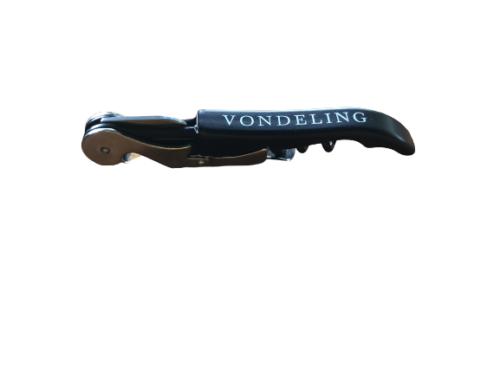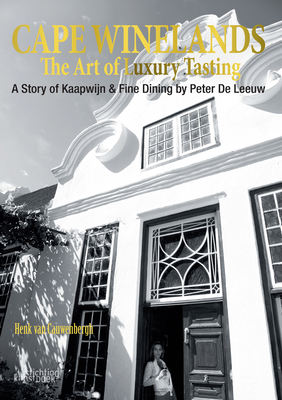-
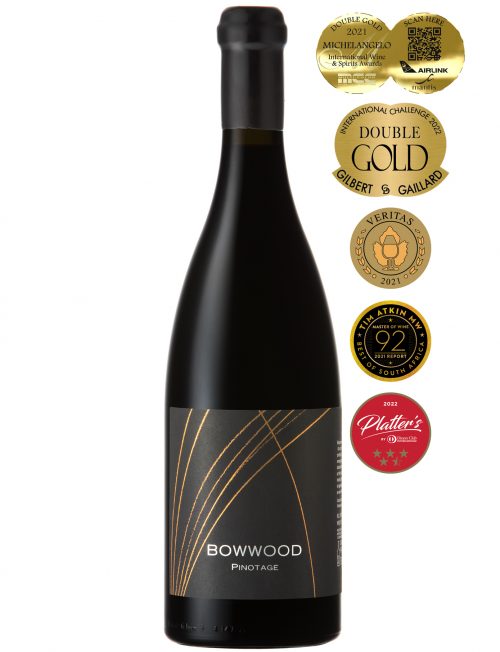 (100% Pinotage) VINEYARDS Bowwood Pinotage is made from a small, single vineyard, planted in clay-rich gravel soils in 1998. The vineyard is shy bearing with poor vigour, which ensures tiny berries with hugely concentrated flavour. A North-South row orientation exposes the grapes to plenty of gentle morning and late afternoon sunshine, perfect for intense colour and aromatic development. VINIFICATION The grapes are hand-picked in early February with a ripeness of 25 Balling. Each bunch is pre-chilled before being destemmed and berry sorted. The berries are not crushed but are fermented whole. This allows for a gradual extraction of tannins and colour, which promotes finesse, balance and longevity. The berries are fermented in open-top fermenters, which provide easy access for the winemaker to assess and manipulate the fermentation. The wine is punched down regularly for 8 days and then basket pressed directly to new and second fill, 300L American oak barrels. Malolactic fermentation takes place in the barrel, which promotes harmony and seamless integration of the oak flavours. The wine is further matured on the yeast and malolactic lees for 18 months. At this point, the finest 12 barrels are selected, blended and returned to barrel for an additional 6 months. Finally, the wine is kept for 4 months in a stainless-steel tank to promote stability and clarification, before it is bottled and laid to rest for a full year before it is released. FURTHER REMARKS Bowwood Pinotage is made to rival the best wines in the world and will benefit greatly from additional cellaring. This is only the six vintage. TASTING NOTES & CELLARING & FOOD PAIRING Opaque in colour with dark hues of purple and red, it delivers an intense black cherry and plum bouquet interlaced with sweet cloves and vanillarich oak. Bold fruit and pungent spice aromatics persist on the palate with undertones of roasted almonds and cigar smoke. The palate is broad and rich with soft acidity and abundant, fine tannin. A luxurious, full-flavored, and modern wine. Accolades 2020 Vintage: 2023 Michelangelo- Double Gold 2023 Veritas-Double Gold 2024 Platter’s Guide- 4.5 Stars (91 Pts) 2019 Vintage: 2022 ABSA TOP 10 Winner 2022 Veritas- Double Gold Vintage 2018: 2021 Michelangelo – Double Gold 2021 Veritas – Gold 2022 Platter’s Guide – 4.5 Stars (94pts) 2022 Gilbert & Gaillard -Double Gold (92pts) Analysis pH 3.52 Total Acidity 5.8 g/l Residual Sugar 3.5 g/l Alcohol 14.48 % Download Tasting Sheet
(100% Pinotage) VINEYARDS Bowwood Pinotage is made from a small, single vineyard, planted in clay-rich gravel soils in 1998. The vineyard is shy bearing with poor vigour, which ensures tiny berries with hugely concentrated flavour. A North-South row orientation exposes the grapes to plenty of gentle morning and late afternoon sunshine, perfect for intense colour and aromatic development. VINIFICATION The grapes are hand-picked in early February with a ripeness of 25 Balling. Each bunch is pre-chilled before being destemmed and berry sorted. The berries are not crushed but are fermented whole. This allows for a gradual extraction of tannins and colour, which promotes finesse, balance and longevity. The berries are fermented in open-top fermenters, which provide easy access for the winemaker to assess and manipulate the fermentation. The wine is punched down regularly for 8 days and then basket pressed directly to new and second fill, 300L American oak barrels. Malolactic fermentation takes place in the barrel, which promotes harmony and seamless integration of the oak flavours. The wine is further matured on the yeast and malolactic lees for 18 months. At this point, the finest 12 barrels are selected, blended and returned to barrel for an additional 6 months. Finally, the wine is kept for 4 months in a stainless-steel tank to promote stability and clarification, before it is bottled and laid to rest for a full year before it is released. FURTHER REMARKS Bowwood Pinotage is made to rival the best wines in the world and will benefit greatly from additional cellaring. This is only the six vintage. TASTING NOTES & CELLARING & FOOD PAIRING Opaque in colour with dark hues of purple and red, it delivers an intense black cherry and plum bouquet interlaced with sweet cloves and vanillarich oak. Bold fruit and pungent spice aromatics persist on the palate with undertones of roasted almonds and cigar smoke. The palate is broad and rich with soft acidity and abundant, fine tannin. A luxurious, full-flavored, and modern wine. Accolades 2020 Vintage: 2023 Michelangelo- Double Gold 2023 Veritas-Double Gold 2024 Platter’s Guide- 4.5 Stars (91 Pts) 2019 Vintage: 2022 ABSA TOP 10 Winner 2022 Veritas- Double Gold Vintage 2018: 2021 Michelangelo – Double Gold 2021 Veritas – Gold 2022 Platter’s Guide – 4.5 Stars (94pts) 2022 Gilbert & Gaillard -Double Gold (92pts) Analysis pH 3.52 Total Acidity 5.8 g/l Residual Sugar 3.5 g/l Alcohol 14.48 % Download Tasting Sheet -
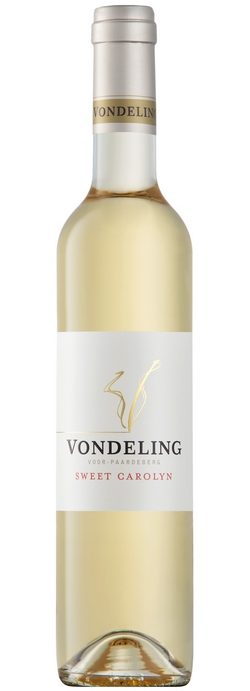 (100% Muscat de Frontignan) VINEYARDS This wine is made from a single vineyard of Muscat d’Frontignan. The winemaking begins in the vineyard. When the acidity and sugar are in perfect harmony, the stem of each bunch is individually crimped to isolate the bunch from the vine. The crimping process stops the supply of water to the bunch, causing the berries to desiccate on the vine. Crimping is done before the grapes are 100% ripe and still high in natural acidity. The crimping process concentrates the sugar and the acidity of the berries and takes up to two weeks. The grapes are naturally protected from the sun by the vine canopy and air movement across the berries stops moulds and fungi from forming while they are drying. Finally, the fruit is ready for picking. VINIFICATION The dried grapes are hand-picked and chilled overnight. They are then destemmed, but not crushed, directly to open top fermenters. Here the berries are fermented much like a red wine, with periodic punch downs, to extract all the syrupy juice from inside. This method adds structure to the wine and the light tannins help to preserve fruity freshness. After approximately one week on the skins, they are pressed, and fermentation is completed in tank. Fermentation stops naturally when the combination of high acidity, increasing alcohol and concentrated sugar finally becomes too inhibitory for the yeast. The wine is aged for 11 months on the gross lees before it is bottled. TASTING NOTES & CELLARING & FOOD PAIRING The wine displays a golden to light amber colour. It has a perfumed nose of bright pineapple, ripe apricot, honeyed marmalade and seductive rose petal. These heady aromas are supported by orange blossom, jasmine and wild rosemary. The nose carries through to the taste, where the mouth-watering sweetness is cut by a tangy acidity, which ensures a persistent and refreshing finish. This is a naturally fermented and unfortified wine, and allows for many delightful treats, which may incl. savoury duck liver pate, sweet spice-laced puddings and traditional soft cheeses. Serve chilled and don’t wait for dessert. Accolades 2022 Platter’s Guide – 4.5 Stars
(100% Muscat de Frontignan) VINEYARDS This wine is made from a single vineyard of Muscat d’Frontignan. The winemaking begins in the vineyard. When the acidity and sugar are in perfect harmony, the stem of each bunch is individually crimped to isolate the bunch from the vine. The crimping process stops the supply of water to the bunch, causing the berries to desiccate on the vine. Crimping is done before the grapes are 100% ripe and still high in natural acidity. The crimping process concentrates the sugar and the acidity of the berries and takes up to two weeks. The grapes are naturally protected from the sun by the vine canopy and air movement across the berries stops moulds and fungi from forming while they are drying. Finally, the fruit is ready for picking. VINIFICATION The dried grapes are hand-picked and chilled overnight. They are then destemmed, but not crushed, directly to open top fermenters. Here the berries are fermented much like a red wine, with periodic punch downs, to extract all the syrupy juice from inside. This method adds structure to the wine and the light tannins help to preserve fruity freshness. After approximately one week on the skins, they are pressed, and fermentation is completed in tank. Fermentation stops naturally when the combination of high acidity, increasing alcohol and concentrated sugar finally becomes too inhibitory for the yeast. The wine is aged for 11 months on the gross lees before it is bottled. TASTING NOTES & CELLARING & FOOD PAIRING The wine displays a golden to light amber colour. It has a perfumed nose of bright pineapple, ripe apricot, honeyed marmalade and seductive rose petal. These heady aromas are supported by orange blossom, jasmine and wild rosemary. The nose carries through to the taste, where the mouth-watering sweetness is cut by a tangy acidity, which ensures a persistent and refreshing finish. This is a naturally fermented and unfortified wine, and allows for many delightful treats, which may incl. savoury duck liver pate, sweet spice-laced puddings and traditional soft cheeses. Serve chilled and don’t wait for dessert. Accolades 2022 Platter’s Guide – 4.5 Stars2017 Vintage:
2020 Platter’s Guide – 4.5 Stars 2018 James Suckling SA Report 90 points
Analysis pH 3.38 Total Acidity 6.4 g/l Residual Sugar 177.6 g/l Alcohol 12.38 % Download Tasting Sheet -
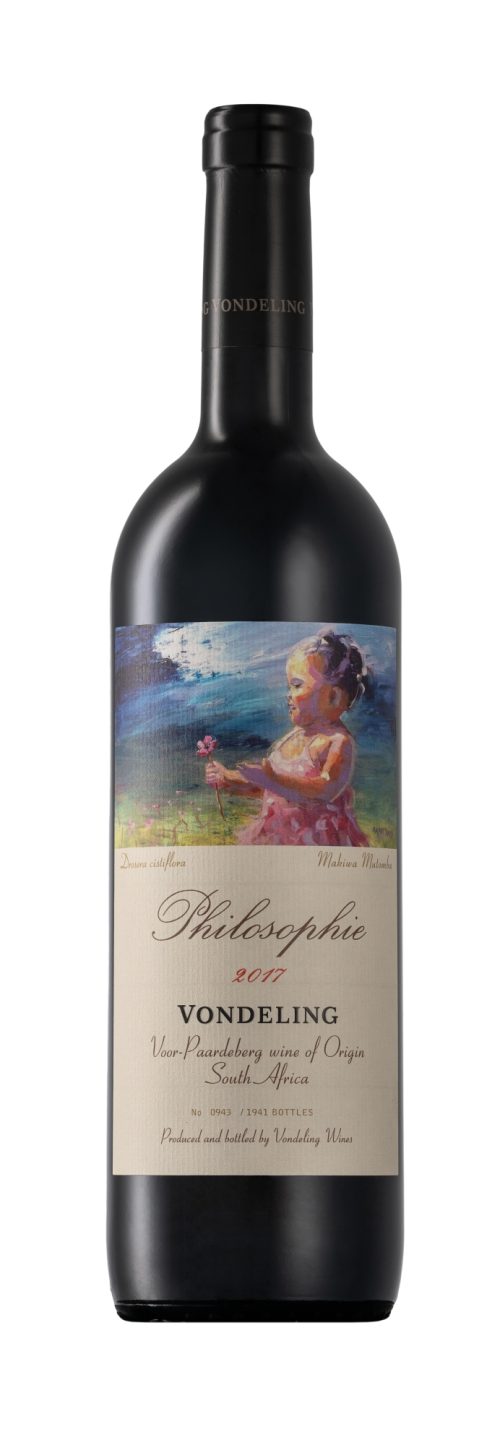 LIMITED RELEASE Philosophie is a brave endeavour in which we attempt to marry the mind, the heart and the soil as we celebrate the diversity of Vondeling. THE STORY BEHIND THE LABEL Each year a celebrated artist is recruited to illustrate a rare Paardeberg flower in the medium of their choice. This unique rendition is placed on a numbered selection of Vondeling’s finest bottles to create a series of collectable and rare wines. Drosera cistiflora is a perennial, carnivorous flower uniquely occurring in its red form in our region. Beautifully rendered in oil on canvas by the inspirational talent of Makiwa Mutomba, adding a sense of place and delight to this endearing wine. VINEYARDS In a handful of specific vineyards, we explore the absolute limits of quality with no consideration to cost. 2017 is a unique vintage with Cabernet Sauvignon as the dominant grape. Each vineyard is carefully assessed at the end of the growing season and attentively pruned during the winter. At bud burst, any shoots which develop poorly are immediately removed. This ensures that the remaining shoots have plenty of energy to grow sturdy, fertile flowers and facilitate a uniform berry set. As the grapes develop only one bunch per cane is selected and the rest are dropped to the ground. This lowers the load on the vine, removing any plant stress and allowing perfect flavour and tannin development. It also diminishes any need for irrigation and helps preserve the grape’s natural acidity. VINIFICATION Once deemed to have reached optimal ripeness the grapes are hand-picked and refrigerated for 24hrs. The bunches are carefully destemmed, but not crushed and the berries are individually sorted to remove any green material. The berries are not pumped, but ferried, via conveyor to open-top fermenters. Cold soaking is done at 6 degrees Celsius for a period of 5 days. Cold soaking is a process that allows only partial degradation of the grape cell wall, to gently extract the fruit flavours and aromatics situated below the surface of the skin. Subtle tannin extraction protects these delicate flavours and promotes colour stability. As the berries slowly come to room temperature, ambient yeasts commence with spontaneous fermentation. This natural fermentation by multiple yeast strains, is preferable, as it will ensure that the wine has complexity and character. A cool fermentation temperature slows the rate of fermentation and affords the winemaker adequate time to assess and manipulate the character of the wine, thus unlocking its full potential. Full extraction is ensured by regular punch downs after three weeks of maceration the skins are gently pressed in a traditional basket press. From the press, the wine moves directly to 300L French Oak barrels for malolactic fermentation. This slow bacterial degradation of the wine’s harsher acidity has the welcome side effect of meshing the oak and natural fruit flavours into a seamless package. Two-thirds of the barrels are new. The wine remains on its yeast and malolactic lees for 14 months before the best 10 barrels are selected, blended and returned for an additional 8 months of maturation. Of these 10 barrels, only 5 are selected for the final blend. The wine is bottled after 3 months in tank and bottle matured for at least two years before release. TASTING NOTES & CELLARING & FOOD PAIRING A deep but vibrant, scarlet red colour. A wonderfully expressive and enthusiastic nose. Bursting with bright red cherry and high floral notes. Beautifully laced with sweet vanilla and subtle wood shavings. The palate is precise and bold with delightful tension. Ripe raspberry and cinnamon lead with underlying layers of trimmed cigar and fine tannin. Pairs well with steak, especially richer steak dishes such as tournedos Rossini, posh burgers and Roast duck. Accolades 2017 Vintage: 2021 Tim Atkin - 89 Points 2016 Vintage: 2022 Platter's Guide - 4.5 Stars (94pts) 2015 Vintage: 2018 Platter’s Guide – 4.5 Stars 2020 Platter’s Guide – 4.5 Stars 2020 Tim Atkin 93 Points 2020 Winemag – 92 points 2020 Veritas – Silver Outstanding 2021 Platter’s Guide – 4.5 stars (94 pts) Analysis pH 3.6 Total Acidity 6.4 g/l Residual Sugar 3.4 g/l Alcohol 14.3 % Download Tasting Sheet
LIMITED RELEASE Philosophie is a brave endeavour in which we attempt to marry the mind, the heart and the soil as we celebrate the diversity of Vondeling. THE STORY BEHIND THE LABEL Each year a celebrated artist is recruited to illustrate a rare Paardeberg flower in the medium of their choice. This unique rendition is placed on a numbered selection of Vondeling’s finest bottles to create a series of collectable and rare wines. Drosera cistiflora is a perennial, carnivorous flower uniquely occurring in its red form in our region. Beautifully rendered in oil on canvas by the inspirational talent of Makiwa Mutomba, adding a sense of place and delight to this endearing wine. VINEYARDS In a handful of specific vineyards, we explore the absolute limits of quality with no consideration to cost. 2017 is a unique vintage with Cabernet Sauvignon as the dominant grape. Each vineyard is carefully assessed at the end of the growing season and attentively pruned during the winter. At bud burst, any shoots which develop poorly are immediately removed. This ensures that the remaining shoots have plenty of energy to grow sturdy, fertile flowers and facilitate a uniform berry set. As the grapes develop only one bunch per cane is selected and the rest are dropped to the ground. This lowers the load on the vine, removing any plant stress and allowing perfect flavour and tannin development. It also diminishes any need for irrigation and helps preserve the grape’s natural acidity. VINIFICATION Once deemed to have reached optimal ripeness the grapes are hand-picked and refrigerated for 24hrs. The bunches are carefully destemmed, but not crushed and the berries are individually sorted to remove any green material. The berries are not pumped, but ferried, via conveyor to open-top fermenters. Cold soaking is done at 6 degrees Celsius for a period of 5 days. Cold soaking is a process that allows only partial degradation of the grape cell wall, to gently extract the fruit flavours and aromatics situated below the surface of the skin. Subtle tannin extraction protects these delicate flavours and promotes colour stability. As the berries slowly come to room temperature, ambient yeasts commence with spontaneous fermentation. This natural fermentation by multiple yeast strains, is preferable, as it will ensure that the wine has complexity and character. A cool fermentation temperature slows the rate of fermentation and affords the winemaker adequate time to assess and manipulate the character of the wine, thus unlocking its full potential. Full extraction is ensured by regular punch downs after three weeks of maceration the skins are gently pressed in a traditional basket press. From the press, the wine moves directly to 300L French Oak barrels for malolactic fermentation. This slow bacterial degradation of the wine’s harsher acidity has the welcome side effect of meshing the oak and natural fruit flavours into a seamless package. Two-thirds of the barrels are new. The wine remains on its yeast and malolactic lees for 14 months before the best 10 barrels are selected, blended and returned for an additional 8 months of maturation. Of these 10 barrels, only 5 are selected for the final blend. The wine is bottled after 3 months in tank and bottle matured for at least two years before release. TASTING NOTES & CELLARING & FOOD PAIRING A deep but vibrant, scarlet red colour. A wonderfully expressive and enthusiastic nose. Bursting with bright red cherry and high floral notes. Beautifully laced with sweet vanilla and subtle wood shavings. The palate is precise and bold with delightful tension. Ripe raspberry and cinnamon lead with underlying layers of trimmed cigar and fine tannin. Pairs well with steak, especially richer steak dishes such as tournedos Rossini, posh burgers and Roast duck. Accolades 2017 Vintage: 2021 Tim Atkin - 89 Points 2016 Vintage: 2022 Platter's Guide - 4.5 Stars (94pts) 2015 Vintage: 2018 Platter’s Guide – 4.5 Stars 2020 Platter’s Guide – 4.5 Stars 2020 Tim Atkin 93 Points 2020 Winemag – 92 points 2020 Veritas – Silver Outstanding 2021 Platter’s Guide – 4.5 stars (94 pts) Analysis pH 3.6 Total Acidity 6.4 g/l Residual Sugar 3.4 g/l Alcohol 14.3 % Download Tasting Sheet -
 (Cabernet Sauvignon 64% ,Merlot 21%, Cabernet Franc 15%) LIMITED RELEASE Philosophie is a brave endeavor in which we attempt to marry the mind, the heart, and the soil as we celebrate the diversity of Vondeling. THE STORY BEHIND THE LABEL Each year a celebrated artist is recruited to illustrate a rare Paardeberg flower in the medium of their choice. This unique artistic rendition of the chosen flower serves as the flag bearer, not only of the vintage, but also of the unique terroir in which the grapes are grown. These special labels are placed on a curated selection of Vondeling’s finest barrels to create a series of collectable, rare wines. Each bottle is individually numbered within the series. This year, we’ve chosen Monsonia speciosa, an endangered member of the geranium family, which grows in the Paardeberg. Its attractive pink and white petals have earned it, its common name the Butterfly or Umbrella Flower. This year’s beautiful image was done in oil paint, by the renowned Wiltshire-based artist, Emma Haggas – hereby adding emotion to place. VINEYARDS On Vondeling, in a handful of site-specific vineyards, we employ the very finest viticultural and scientific methods to explore the limits of quality grape production. Each vineyard is carefully assessed at the end of the growing season and attentively pruned during the winter months. At bud burst, any shoots which develop poorly are immediately removed. This ensures that the remaining canes are robust with plenty of energy to ensure fertile flowers and uniform berry set. As the grapes develop, only the best bunch per cane is selected and the rest are dropped to the ground. This lowers the load on the vine, thereby removing any stress in the plant and allowing perfect flavour and tannin development. It also diminishes any need for irrigation and helps preserve the grape’s natural acidity. VINIFICATION Once deemed to have reached optimal ripeness the grapes are hand- picked and refrigerated for 24hrs. The bunches are gently destemmed, but the berries are kept intact for individual berry sorting during which any green material and unripe berries are removed. The berries are not pumped, but ferried, via conveyor to open-top fermenters. This reduces the amount of juice exposed to degradation by oxygen. Cold soaking is done at 6 ˚C for a period of 3 days. Cold soaking is a process which facilitates partial degradation of the grape cell wall, to gently extract the flavours and aromatics situated below the surface of the skin. Subtle tannin extraction protects these delicate flavours and promotes colour stability. As the berries slowly come to room temperature, spontaneous fermentation begins due to the presence of natural, ambient yeast. This natural fermentation by multiple yeast strains, is preferable, as it furthers the regional expression of the wine while promoting complexity and character. A cool fermentation temperature slows the rate of fermentation and affords our winemaker adequate time to assess and manipulate the character of the wine, thus unlocking its full potential. Full extraction is ensured by regular punch downs during a two-week ferment. The skins are further macerated post-fermentation for a week before they’re pressed in a traditional basket press. From the press, the wine moves to 300L French Oak barrels for malolactic fermentation. This slow bacterial degradation of the wine’s harsher acidity has the welcome side effect of meshing the oak and natural fruit flavours into a seamless package. Two-thirds of the barrels are new. The wine remains on its yeast and malolactic lees for 14 months before the best 10 barrels are selected. These barrels are blended and returned for an additional 8 months of maturation. Of these 10 barrels only 5 are selected for the final blend. The wine is bottled after 3 months in tank and bottle matured for at least two years before release. TASTING NOTES & CELLARING & FOOD PAIRING The colour is a near-opaque charcoal red with a dense, scarlet hue. The nose has a superb sense of plush black current, wonderfully restrained and balanced by a hint of graphite. At the same time, the delicate floral notes of the Cabernet Franc are seamlessly infused with notes of sweet raspberry, uplifting aniseed and a hint of pencil shavings. The palate has a dense, weighted presence with a persistent finish. The tannins of this powerful wine are quite precise and balance the abundant ripe berry flavours beautifully. Bright notes of cinnamon and vanilla flow through the berry melange and are supported by seamless oak. This wine’s complex character lends itself to richer cuts of meat and dishes redolent with layers of umami-laden flavour. The likes of pan-seared duck, slow-roasted beef and venison goulash are all excellent counterparts, as are posh burgers with all the trimmings and saucy Tournedos Rossini. Accolades 2016 Vintage: 2022 Platter Guide - 4.5 Stars(94 Points) 2017 Vintage: 2023 Platter Guide - 5 Stars (96 Points) 2019 Vintage: 2024 Platter Guide -5 Stars(97 Points) & Category winner (Cape Bordeux Blend) Analysis pH 3.73 Total Acidity 5.5 g/l Residual Sugar 3.7 g/l Alcohol 14.64 % Download tasting notes
(Cabernet Sauvignon 64% ,Merlot 21%, Cabernet Franc 15%) LIMITED RELEASE Philosophie is a brave endeavor in which we attempt to marry the mind, the heart, and the soil as we celebrate the diversity of Vondeling. THE STORY BEHIND THE LABEL Each year a celebrated artist is recruited to illustrate a rare Paardeberg flower in the medium of their choice. This unique artistic rendition of the chosen flower serves as the flag bearer, not only of the vintage, but also of the unique terroir in which the grapes are grown. These special labels are placed on a curated selection of Vondeling’s finest barrels to create a series of collectable, rare wines. Each bottle is individually numbered within the series. This year, we’ve chosen Monsonia speciosa, an endangered member of the geranium family, which grows in the Paardeberg. Its attractive pink and white petals have earned it, its common name the Butterfly or Umbrella Flower. This year’s beautiful image was done in oil paint, by the renowned Wiltshire-based artist, Emma Haggas – hereby adding emotion to place. VINEYARDS On Vondeling, in a handful of site-specific vineyards, we employ the very finest viticultural and scientific methods to explore the limits of quality grape production. Each vineyard is carefully assessed at the end of the growing season and attentively pruned during the winter months. At bud burst, any shoots which develop poorly are immediately removed. This ensures that the remaining canes are robust with plenty of energy to ensure fertile flowers and uniform berry set. As the grapes develop, only the best bunch per cane is selected and the rest are dropped to the ground. This lowers the load on the vine, thereby removing any stress in the plant and allowing perfect flavour and tannin development. It also diminishes any need for irrigation and helps preserve the grape’s natural acidity. VINIFICATION Once deemed to have reached optimal ripeness the grapes are hand- picked and refrigerated for 24hrs. The bunches are gently destemmed, but the berries are kept intact for individual berry sorting during which any green material and unripe berries are removed. The berries are not pumped, but ferried, via conveyor to open-top fermenters. This reduces the amount of juice exposed to degradation by oxygen. Cold soaking is done at 6 ˚C for a period of 3 days. Cold soaking is a process which facilitates partial degradation of the grape cell wall, to gently extract the flavours and aromatics situated below the surface of the skin. Subtle tannin extraction protects these delicate flavours and promotes colour stability. As the berries slowly come to room temperature, spontaneous fermentation begins due to the presence of natural, ambient yeast. This natural fermentation by multiple yeast strains, is preferable, as it furthers the regional expression of the wine while promoting complexity and character. A cool fermentation temperature slows the rate of fermentation and affords our winemaker adequate time to assess and manipulate the character of the wine, thus unlocking its full potential. Full extraction is ensured by regular punch downs during a two-week ferment. The skins are further macerated post-fermentation for a week before they’re pressed in a traditional basket press. From the press, the wine moves to 300L French Oak barrels for malolactic fermentation. This slow bacterial degradation of the wine’s harsher acidity has the welcome side effect of meshing the oak and natural fruit flavours into a seamless package. Two-thirds of the barrels are new. The wine remains on its yeast and malolactic lees for 14 months before the best 10 barrels are selected. These barrels are blended and returned for an additional 8 months of maturation. Of these 10 barrels only 5 are selected for the final blend. The wine is bottled after 3 months in tank and bottle matured for at least two years before release. TASTING NOTES & CELLARING & FOOD PAIRING The colour is a near-opaque charcoal red with a dense, scarlet hue. The nose has a superb sense of plush black current, wonderfully restrained and balanced by a hint of graphite. At the same time, the delicate floral notes of the Cabernet Franc are seamlessly infused with notes of sweet raspberry, uplifting aniseed and a hint of pencil shavings. The palate has a dense, weighted presence with a persistent finish. The tannins of this powerful wine are quite precise and balance the abundant ripe berry flavours beautifully. Bright notes of cinnamon and vanilla flow through the berry melange and are supported by seamless oak. This wine’s complex character lends itself to richer cuts of meat and dishes redolent with layers of umami-laden flavour. The likes of pan-seared duck, slow-roasted beef and venison goulash are all excellent counterparts, as are posh burgers with all the trimmings and saucy Tournedos Rossini. Accolades 2016 Vintage: 2022 Platter Guide - 4.5 Stars(94 Points) 2017 Vintage: 2023 Platter Guide - 5 Stars (96 Points) 2019 Vintage: 2024 Platter Guide -5 Stars(97 Points) & Category winner (Cape Bordeux Blend) Analysis pH 3.73 Total Acidity 5.5 g/l Residual Sugar 3.7 g/l Alcohol 14.64 % Download tasting notes -
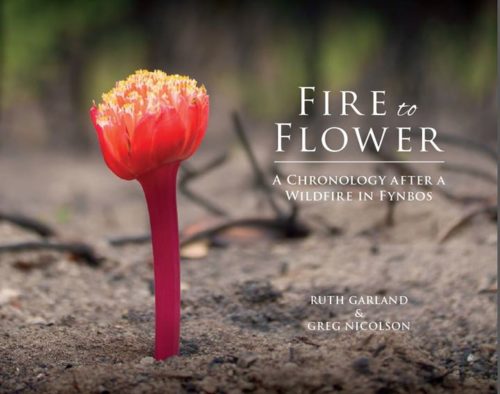 This publication materialised following a fire on the Paardeberg, which burnt 75% of the mountain above the farmlands. Being the first fire in 25 years, it offered an unmatched opportunity to document and observe the emergent plant species as they germinated and flowered. Sponsored by Anthony Ward, of Vondeling Wine Estate, botanist and photographer Greg Nicolson recorded and archived images and specimens over 18 months, in consultation with the Compton Herbarium. He collected over 1000 species, including one species new to science, and a number of new distribution records. Walking the mountain for over 18 months, gave Greg a broad view of animal, bird and insect inhabitants of the Paardeberg that have been included among the flowers. Ruth Garland was invited to write text to the publication, which is designed to highlight an appreciation of the diversity and beauty of this part of the matchless Cape Floral Kingdom. This book is primarily to give pleasure to those who love the natural world while also providing an opportunity to learn more about a spectacular part of it, so that it is treasured and adequately protected for generations to come.
This publication materialised following a fire on the Paardeberg, which burnt 75% of the mountain above the farmlands. Being the first fire in 25 years, it offered an unmatched opportunity to document and observe the emergent plant species as they germinated and flowered. Sponsored by Anthony Ward, of Vondeling Wine Estate, botanist and photographer Greg Nicolson recorded and archived images and specimens over 18 months, in consultation with the Compton Herbarium. He collected over 1000 species, including one species new to science, and a number of new distribution records. Walking the mountain for over 18 months, gave Greg a broad view of animal, bird and insect inhabitants of the Paardeberg that have been included among the flowers. Ruth Garland was invited to write text to the publication, which is designed to highlight an appreciation of the diversity and beauty of this part of the matchless Cape Floral Kingdom. This book is primarily to give pleasure to those who love the natural world while also providing an opportunity to learn more about a spectacular part of it, so that it is treasured and adequately protected for generations to come.

